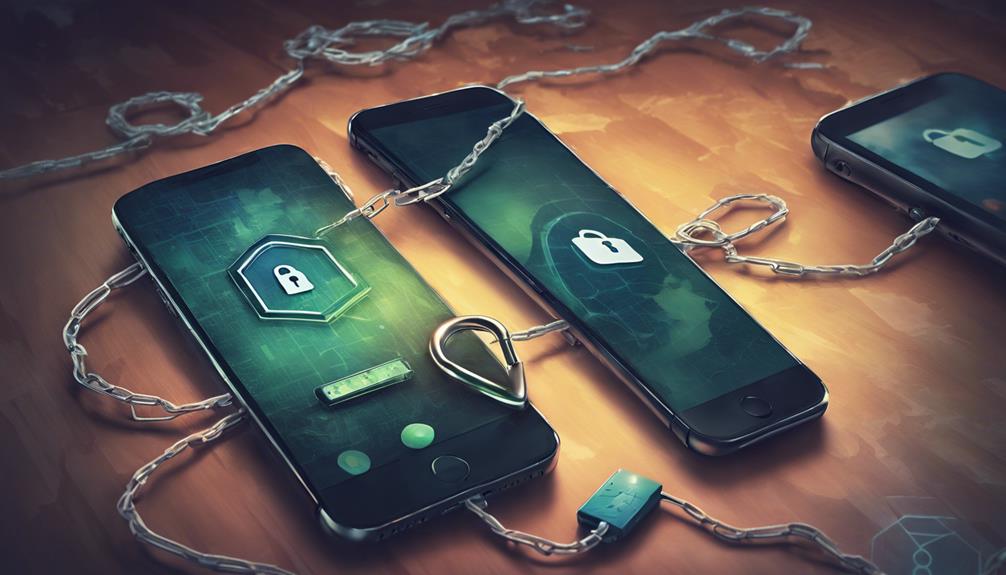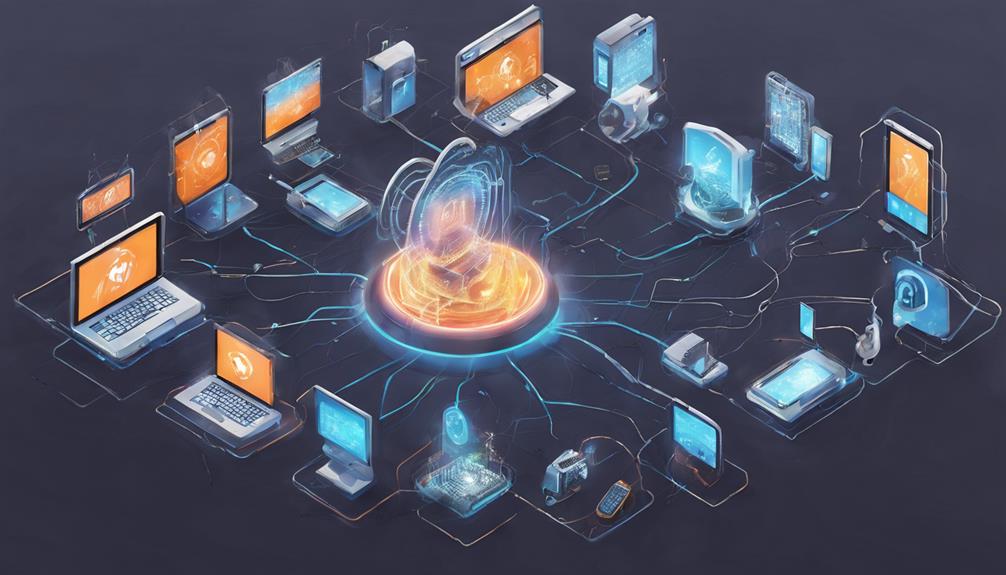To shield your iPhone from hackers, establish a robust 6-digit passcode including alphanumeric characters. Employ two-factor authentication with trusted devices for secure logins. Be cautious of suspicious messages, avoid clicking on unknown links, and delete unsolicited emails to thwart phishing attempts. Safeguard your internet connection with a reputable VPN to encrypt data and guarantee secure browsing. Disabling Siri on the lock screen boosts iPhone security. Utilize the Find My app for remote device erasure as an added security layer. Implement these strategies to fortify your iPhone against potential cyber threats.
Key Takeaways
- Use a strong 6-digit passcode to secure your iPhone.
- Enable two-factor authentication for added security.
- Avoid clicking on suspicious links or messages.
- Utilize a reputable VPN for secure internet browsing.
- Enable remote data erase with Find My app for additional protection.
Strong Passcode Protection
Utilizing a 6-digit or longer passcode is vital for bolstering the security of your iPhone against potential hackers. When setting up your iPhone, opting for a strong passcode rather than a common one like '1111' or '123456' greatly enhances its protection.
A 6-digit passcode offers an impressive one million possible combinations, making it harder for unauthorized individuals to gain access to your device. For even greater security, consider using alphanumeric codes that include a mix of letters, numbers, and special characters.
Additionally, it is essential to disable Siri on the lock screen to prevent any potential breaches of your iPhone's security. By taking these steps to fortify your iPhone's defenses with a robust passcode and limiting access through the lock screen, you substantially reduce the risk of unauthorized entry into your device and protect sensitive information such as your Apple ID password.
Two-Factor Authentication Setup

When setting up two-factor authentication on your iPhone, it is important to take into account secure sign-in methods, verification code access, and trusted device management. These aspects play a vital role in ensuring that your Apple ID remains protected from unauthorized access and potential hacking attempts.
Secure Sign-In Methods
Enhance the security of your iPhone by implementing two-factor authentication for secure sign-in methods.
By enabling two-factor authentication on your Apple ID, you add an additional layer of security that helps safeguard your device from unauthorized access.
Utilizing a trusted device as the second factor for signing in securely guarantees that only authorized individuals can access your information.
This security measure, in conjunction with a unique passcode, helps protect your Apple ID and, by extension, your iPhone from potential security breaches.
Two-factor authentication is a recommended security practice to protect your device and personal data from hackers.
It is essential to prioritize the security of your Apple ID by setting up two-factor authentication and establishing secure sign-in methods, such as using Touch ID or Face ID, to fortify the protection of your device and sensitive information.
Verification Code Access
Setting up two-factor authentication on your iPhone provides an additional layer of security by requiring a verification code in addition to your password for access.
This verification code is a vital component of the two-factor authentication process, ensuring that only authorized users can access your device.
Typically, the verification code is sent to your trusted device or phone number, adding an extra step to verify your identity.
By enabling two-factor authentication, you can secure your iPhone and protect your personal information from potential hackers.
This security measure acts as a barrier against unauthorized access, greatly reducing the risk of data breaches or privacy violations.
With the prevalence of cyber threats in today's digital landscape, setting up two-factor authentication is a proactive step towards enhancing the security of your iPhone and safeguarding your sensitive information.
Trusted Device Management
To further strengthen the security measures on your iPhone, managing trusted devices for two-factor authentication is essential. When setting up two-factor authentication, having a trusted device allows you to receive verification codes for secure login to your Apple account.
By adding trusted devices such as iPads or MacBooks, you not only guarantee convenient access but also enhance the security of your account. These trusted devices play an important role in providing an additional layer of security when logging into various Apple services, safeguarding your iPhone data from unauthorized access.
It is imperative to keep your trusted devices secure to prevent any unauthorized individuals from gaining access to your sensitive information. By managing and regularly updating your trusted devices, you can significantly decrease the risk of potential security breaches and protect your iPhone data effectively.
Avoiding Suspicious Messages and Links

When it comes to safeguarding your iPhone from potential hacking threats, it is important to exercise caution when dealing with messages and links.
Beware of phishing emails that attempt to deceive you into revealing personal information. Avoid clicking on unknown links and stay vigilant when it comes to messages from unfamiliar sources.
Beware of Phishing Emails
Ensuring the safety of your iPhone involves being vigilant against phishing emails, particularly by avoiding suspicious messages and links that could compromise your device's security. Phishing emails are crafted by hackers to deceive individuals into divulging sensitive information, leading to potential malware installation and data theft. It is important to exercise caution when encountering suspicious emails, as they often serve as a gateway to phishing attacks aimed at extracting personal data such as passwords and financial details.
To better understand the risks associated with phishing emails, consider the following table:
| Phishing Emails | Risks |
|---|---|
| Suspicious links | Malware installation |
| Deceptive attachments | Data theft |
| Requests for info | Sensitive information |
| Unsolicited emails | Phishing attacks |
| False company emails | Security compromise |
Avoid Clicking Unknown Links
Vigilance against unfamiliar links is essential in safeguarding your iPhone from potential security threats. To protect your iPhone, it's important to avoid clicking on unknown links received through unsolicited messages.
Before clicking on any link, take a moment to verify the legitimacy of the website it leads to. Deleting strange messages from unknown numbers can help prevent security breaches and identity theft.
Additionally, ignoring unsolicited emails that contain attachments or links is crucial, as they may harbor malicious content aimed at compromising your device. By refraining from opening links from untrusted sources and only accessing links from reputable and trusted sources, you can better protect your data and privacy.
Stay Vigilant With Messages
Exercising caution when handling messages on your iPhone is essential to safeguarding your device against potential security threats. With the increasing prevalence of cyber attacks, protecting your privacy and ensuring iPhone security is paramount. To stay safe, here are some simple tips to follow when dealing with text messages:
| Simple Tips | Description |
|---|---|
| Verify Sender | Always confirm the legitimacy of the sender before opening any links or attachments. |
| Avoid Unknown Links and Attachments | Be wary of messages containing unfamiliar links or attachments, as they may contain malware. |
| Delete Suspicious Messages | Remove messages from unknown numbers or suspicious sources to avoid security risks. |
| Ignore Unsolicited Emails | Refrain from clicking on links or downloading attachments from unsolicited emails to prevent data breaches. |
Secure Internet Access With VPN

Securing internet access on your iPhone can be achieved effectively through the use of a virtual private network (VPN). VPN apps for iOS offer features like kill switches and DNS leak protection to enhance privacy and security.
By using a reputable VPN provider on your iPhone, you can guarantee data encryption and secure browsing, especially when connecting to public Wi-Fi networks. Public Wi-Fi networks are known to be vulnerable to data theft, making a VPN essential for maintaining secure internet access on your device.
When utilizing a VPN on your iPhone, your internet connection is encrypted, protecting your data from potential hackers who may be lurking on public Wi-Fi networks. This added layer of security helps safeguard your sensitive information and online activities.
Incorporating a VPN into your iPhone usage routine is essential for maintaining a secure online experience, particularly when accessing the internet through public Wi-Fi hotspots.
Disabling Siri on Lock Screen

To enhance the security of your iPhone and prevent unauthorized access, consider disabling Siri on the lock screen. Siri on the lock screen can pose security risks by potentially allowing access to certain features, making your device vulnerable to unauthorized entry. By disabling Siri on the lock screen, you can mitigate these risks and enhance the protection of your device against potential hacking attempts. This simple step guarantees that access to your iPhone requires the passcode, reducing the likelihood of data breaches and safeguarding your personal information.
Disabling Siri on the lock screen can be easily accomplished through the Settings of your iPhone. By taking the proactive measure of turning off this feature, you can boost the overall security of your device and prevent unauthorized users from exploiting Siri to access sensitive data.
Prioritizing security measures such as this can greatly reduce the likelihood of unauthorized access to your iPhone and protect your information from potential threats.
Remote Device Erasure With Find My App

Utilize the Find My app to remotely erase all data from your misplaced or stolen iPhone, safeguarding your personal information from unauthorized access. This essential feature enhances iPhone security by allowing users to protect their personal data in the event of theft or loss.
By following the steps provided in the Find My app, individuals can initiate a secure remote erase process, ensuring that sensitive information remains inaccessible to unauthorized users. Remote device erasure with the Find My app serves as a fundamental step in maintaining the overall security of your iPhone, adding an extra layer of protection against potential threats such as hackers.
It is imperative to take advantage of this feature to effectively protect personal information and prevent any unauthorized access to your device's data. In a digital landscape where privacy and security are paramount, utilizing the remote erase functionality offered by the Find My app is essential in safeguarding your valuable information.
Frequently Asked Questions
How to Make Your Iphone Secure?
To safeguard the security of your iPhone, adopt strong security practices such as enabling two-factor authentication, using a robust passcode, updating iOS regularly, avoiding suspicious links and apps, and being cautious with public Wi-Fi usage.
How Is My Iphone Protected From Hackers?
The security of iPhones against hackers is maintained through measures like strong passcodes, two-factor authentication, avoidance of suspicious links, regular software updates, and the use of VPNs on public Wi-Fi. These strategies help safeguard user data and protect against unauthorized access.
Can Hackers See You Through Your Iphone?
Yes, hackers can potentially access your iPhone camera through malicious apps or unauthorized access. It is essential to stay vigilant, keep your device updated, avoid risky downloads, and utilize security features like two-factor authentication for enhanced protection against unauthorized access.
How to Prevent Someone From Accessing Your Iphone?
To prevent unauthorized access to your iPhone, use a strong passcode, enable biometric authentication methods like Touch ID or Face ID, avoid sharing sensitive information, be vigilant against phishing attempts, and regularly update your device's software to protect against hackers.
Conclusion
To sum up, protecting your iPhone from hackers is essential in today's digital age. By implementing strong passcode protection, enabling two-factor authentication, avoiding suspicious messages and links, utilizing VPN for secure internet access, disabling Siri on the lock screen, and utilizing the Find My app for remote device erasure, you can safeguard your device effectively.
Remember, just as a fortress protects its treasures, these measures shield your personal information from potential cyber threats. Stay vigilant and proactive in safeguarding your digital assets.









